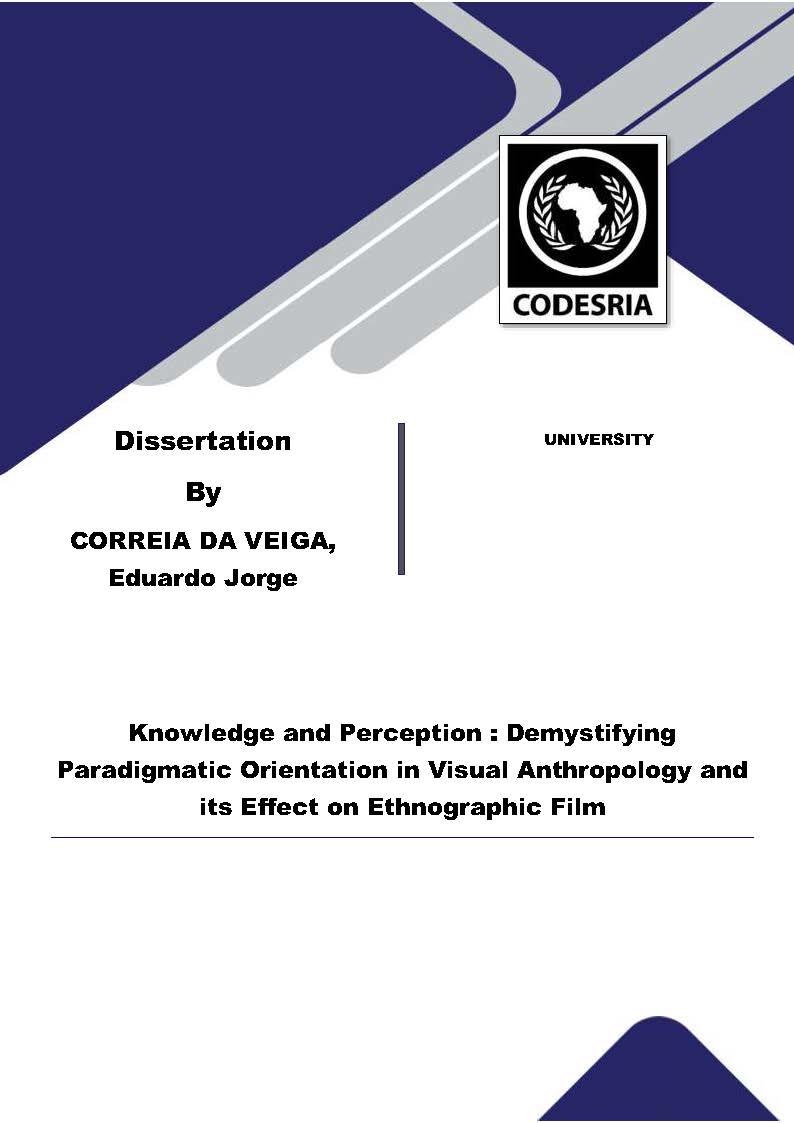Knowledge and Perception :: Demystifying Paradigmatic Orientation in Visual Anthropology and its Effect on Ethnographic Film
Keywords:
Films,, visual arts,, cinema, film industry,, anthropology,, ethnography, social sciences,, Industry,, visual anthropology,, ethnographic, filmSynopsis
Ethnographic film theories, like the social sciences, are divided between positivist theories and interpretive theories. The literature of ethnographic filmmaking only implies this distinction, with the assumption that a certain theory of filmmaking will lead to a certain type of film. However, there are no explicit distinctions in the contemporary literature of what makes a
theory, and thereby a film, either positivist or interpretivist. This dissertation makes an explicit distinction between these types of theories in ethnographic film theory, and then makes use of a semiotic film analysis of each type of film in order to assess if the distinction holds, both theoretically and practically.
Downloads
References
Asch, T., Marshall, J. & Spier, P. (1973). ‘Ethnographic Film: Structure and
Function.’ Annual Review of Anthropology, 1973, pp. 179-187.
Banks, M. & Morphy, H. (eds) (1997) Rethinking Visual Anthropology. New Haven: Yale University
Press
Benton, T. & Craib, I. (2001). Philosophy of Social Science. Hampshire: Palgrave.
Bohr, N. (1987). Volume III - Essays 1958-1962 on Atomic Physics and Human Knowledge. Woodbridge:
Ox Bow Press.
Blumer, H. (1969) Symbolic Interactionism: Perspective and Method. Englewood Cliffs, NJ:
Prentice-Hall.
Crawford, P. (1992). Film as Discourse: The Invention of Anthropological Realities Crawford, P. &
Turton, D. (eds.): Film as Ethnography. Manchester: Manchester
university press.
Crang, M. (2005). ‘Qualitative Methods: There Is Nothing Outside the Text?’
Progress in Human Geography, 29, 2: 225-233
Crotty, M. (2003). The Foundations of Social Research. London: Sage.
Davies, C. (1999). Reflexive Ethnography. London: Routledge.
De Brigard, E. (1995), ‘The History of Ethnographic film’, In P. Hockings (ed.),
Principles of Visual Anthropology, Berlin: Mouton de Gruyter , pp. 13-43.
Denzin, N.K. & Lincoln, Y.S. (2000). ‘Introduction: The Discipline and Practice of Qualitative
Research.’ In N.K. Denzin & Y.S. Lincoln. The Handbook of Qualitative Research (2nd Ed.), Thousand
Oaks: Sage, pp. 1-25.
Dilthey, W. (1989). Introduction to the Human Sciences: An Attempt to Lay a Foundation for the
Study of Society and History. USA: Wayne State University Press.
Eco, U. (1976). A Theory of Semiotics, London: Indiana University Press.
Fabien, J. (1971). Language, History, and Anthropology. Journal of the Philosophy of the Social
Sciences 1, 19-47.
Feyerabend, P.K. (1988). Against Method (rev. edn.) London: Verso.
Gonzalez, N. (1993). ‘An Argument About Film.’ Ruby, J. (ed.) The Cinema of John Marshall.
Switzerland: Harwood.
Grimshaw, A. (2001) The Ethnographer’s Eye. Ways of Seeing in Modern Anthropology. Cambridge:
Cambridge University Press.
Harris, S. (2006) ‘Social Constructionism and Social Inequality: An Introduction to a Special Issue
of JCE Journal of Contemporary Ethnography’, Journal of
Contemporary Ethnography, 35, 3: 223-235.
Hastrup, K. (1992). ‘Anthropological Visions: Some Notes on Visual and Textual
Authority’, In P.I. Crawford and D. Turton (eds.), Film as Ethnography, Manchester: Manchester
university press, pp. 8-25.
Heider, K. (1976). Ethnographic film. Austin, Texas: University of Texas Press
Kuhn, Thomas S. (1970). The Structure of Scientific Revolutions (2nd Ed.). Chicago: University of
Chicago Press.
Loizos, P. (1992). “Admissible Evidence: Film in Anthropology’, In P.I. Crawford and D. Turton
(eds.), Film as Ethnography, Manchester: Manchester university press,
pp. 50-65.
Loizos, P. (1997). ‘First Exits From Observational Realism: Narrative Experiments in
Recent Ethnographic Films.’ In M Banks and H Morphy. (eds.), Rethinking Visual Anthropology, New
Haven: Yale University Press, pp. 81-103.
MacDougall, D. (1998a). Transcultural Cinema. West Sussex: Princeton University
Press.
MacDougall, D. (1998b).’Visual Anthropology and the Ways of Knowing’. In D.
MacDougall Transcultural Cinema. West Sussex: Princeton University Press, pp. 61-
MacDougall, D. (1998c).’Beyond Observational Cinema.’ MacDougall Transcultural
Cinema. West Sussex: Princeton University Press, pp. 125-138.
MacDougall, D. (1998d).’Transcultural Cinema’. In D. MacDougall Transcultural
Cinema. West Sussex: Princeton University Press, pp. 245-274
Marshall, J. (1993). ‘Filming and Learning.’ J, Ruby (ed.). The Cinema of John
Marshall. Switzerland: Harwood.
Mead, G.H. (1964). Selected Writings. (ed.) by A. J. Reck.Chicago: University
Chicago Press.
Mead, M. (1995). ‘Visual Anthropology in a Discipline of Words’, In P. Hockings
(ed.), Principles of Visual Anthropology, Berlin: Mouton de Gruyter, pp. 3-12.
Martínez, W. (1992). ‘Who Constructs Anthropological Knowledge? Toward a Theory of Ethnographic
Film Spectatorship’, Crawford, P.I. and Turton, D. (eds.), Film as Ethnography, Manchester:
Manchester university press, pp. 131-161.
Misak, C. (ed.) (2004). The Cambridge Companion to Peirce. Cambridge: Cambridge
University Press
Moran, D. (2001). Introduction to Phenomenology. London: Routledge
Nichols, B. (1991) Representing Reality. Bloomington & Indianapolis: Indiana University Press.
Prosser, J. (1998). ‘The Status of Image-based Research.’ In J. Prosser (Ed), Image- based
Research, London: Falmer Press, pp. 97-112.
Popper, K. (2002). The Logic of Scientific Discovery. London: Routledge.
Peirce, C.S. (1998). The Essential Peirce: Selected Philosophical Writings( vol. 2), Bloomington:
Indiana University Press.
Peirce, C.S. (1965). Collected Papers of Charles Sanders Pierce (vols I & II). C.
Hartshorne & P. Weiss. (Eds.), Cambridge Massachusetts: Harvard University Press.
Pink, S. (2001). Doing Visual Ethnography. London: Sage publications.
Prins, H. (1997). ‘Visual or Virtual Anthropology? In the Wilderness of a Troubled Genre.’ Reviews
in Anthropology, 26: 279-294
Rabinow, P. & Sullivan, W.M. (1979). ‘The Interpretive Turn: Emergence of an Approach’. In P.
Rabinow & W.M. Sullivan (Eds.). Interpretive Social Science: A Reader. Los Angeles: University of
California Press, pp. 1-21
Ratner, Carl (2002). ‘Subjectivity and Objectivity in Qualitative Methodology’. Forum Qualitative
Sozialforschung / Forum: Qualitative Social Research, 3(3). Available at:
http://www.qualitative-research.net/fqs/fqs-eng.htm [06, 2006].
Ruby, J. (2000). Picturing Culture: Explorations of Film and Anthropology. Chicago: University of
Chicago Press.
Ruby, J (1996) ‘Visual Anthropology.’ In Encyclopaedia of Cultural Anthropology, David Levinson and
Melvin Ember, editors. New York: Henry Holt and Company, vol. 4:1345-1351.
Ruby, J. (1980). ‘Exposing Yourself, Reflexivity, Film, and Anthropology.’
Semiotica, 3, 153-179.
Ruby, J. (1977). The Image Mirrored: Reflexivity and the Documentary Film,
Journal of University Film Association, 29(1), pp. 3-18.
Said, E. (1979). Orientalism, New York: Penguin.
Stoller, P. (1992). The Cinematic Griot: The Ethnography of Jean Rouch. London:
University of Chicago Press.






